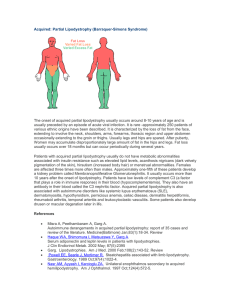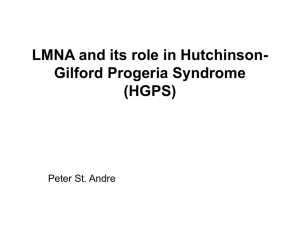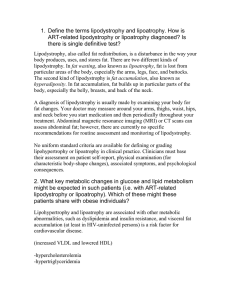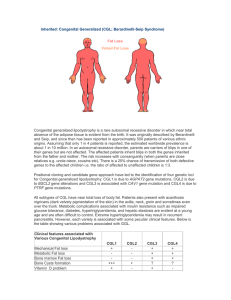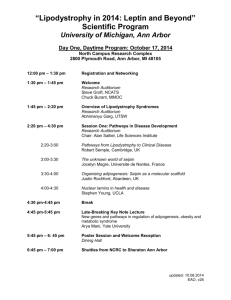Inherited: Familial Partial - Dunnigan Variety (FPLD)
advertisement
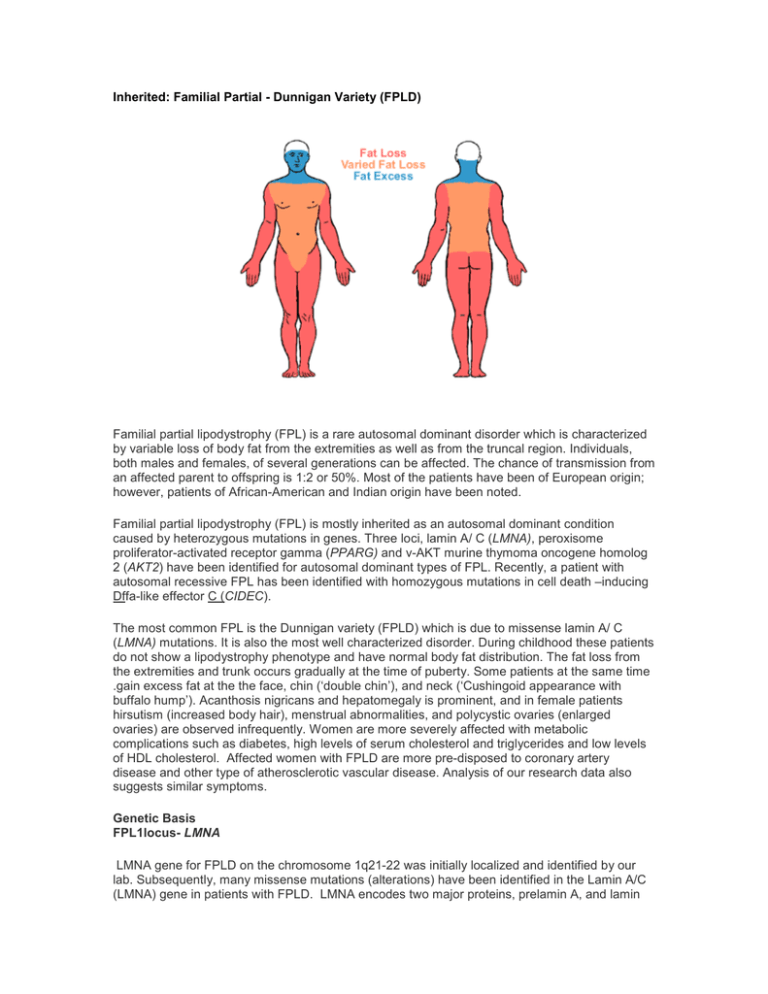
Inherited: Familial Partial - Dunnigan Variety (FPLD) Familial partial lipodystrophy (FPL) is a rare autosomal dominant disorder which is characterized by variable loss of body fat from the extremities as well as from the truncal region. Individuals, both males and females, of several generations can be affected. The chance of transmission from an affected parent to offspring is 1:2 or 50%. Most of the patients have been of European origin; however, patients of African-American and Indian origin have been noted. Familial partial lipodystrophy (FPL) is mostly inherited as an autosomal dominant condition caused by heterozygous mutations in genes. Three loci, lamin A/ C (LMNA), peroxisome proliferator-activated receptor gamma (PPARG) and v-AKT murine thymoma oncogene homolog 2 (AKT2) have been identified for autosomal dominant types of FPL. Recently, a patient with autosomal recessive FPL has been identified with homozygous mutations in cell death –inducing Dffa-like effector C (CIDEC). The most common FPL is the Dunnigan variety (FPLD) which is due to missense lamin A/ C (LMNA) mutations. It is also the most well characterized disorder. During childhood these patients do not show a lipodystrophy phenotype and have normal body fat distribution. The fat loss from the extremities and trunk occurs gradually at the time of puberty. Some patients at the same time .gain excess fat at the the face, chin (‘double chin’), and neck (‘Cushingoid appearance with buffalo hump’). Acanthosis nigricans and hepatomegaly is prominent, and in female patients hirsutism (increased body hair), menstrual abnormalities, and polycystic ovaries (enlarged ovaries) are observed infrequently. Women are more severely affected with metabolic complications such as diabetes, high levels of serum cholesterol and triglycerides and low levels of HDL cholesterol. Affected women with FPLD are more pre-disposed to coronary artery disease and other type of atherosclerotic vascular disease. Analysis of our research data also suggests similar symptoms. Genetic Basis FPL1locus- LMNA LMNA gene for FPLD on the chromosome 1q21-22 was initially localized and identified by our lab. Subsequently, many missense mutations (alterations) have been identified in the Lamin A/C (LMNA) gene in patients with FPLD. LMNA encodes two major proteins, prelamin A, and lamin C, and two minor proteins, by alternative splicing. Lamin A/C gene has 12 exons which by alternative splicing in exon 10 encodes lamin A (full form) or C (short form). Lamin A/C is a component of the nuclear lamina which is located between chromatin and the inner nuclear membrane. Thus, it is likely that missense mutations may affect nuclear function and may result in premature cell death of adipocytes (fat cells), thus causing lipodystrophy. Lamin A/C gene has 12 exons which by alternative splicing in exon 10 encodes lamin A (full form) or C (short form). Three-fourths of the FPLD patients have mutations at the codon position 482 where arginine is replaced by glutamine, leucine or tryptophan on exon 8. Some patients with mutations in exon 11 have been observed to have less severe form of lipodystrophy than those with exon 8 mutations. Rare patients with FPLD reveal mutations in exons 1and 3 and these patients develop cardiomyopathy (disease of heart muscles) which manifests as premature congestive heart failure and cardiac arrhythmias (rhythm disturbances), such as heart blocks and atrial fibrillation necessitating the use of cardiac pacemakers. Some of them had to undergo cardiac transplantation due to poor heart function. Lamins A and C are ubiquitously expressed proteins and therefore why specific mutations affect predominantly adipocytes and not other cells, remains unclear. References • • • • • • • • • • • Ozer FL, Lichtenstein JR, Kwiterovich PO, McKusick VA A new genetic variety of lipodystrophy. Clin Res 1973; 21:533(Abstract). Dunnigan MG, Cochran MDunnigan MGA, Kelly A, Scott JW Familial lipoatrophic diabetes with dominant transmission: a new syndrome. Q J Med 1974; 49:33-48. Davidson MB , Young RT Metabolic studies in familial partial lipodystrophy of the lower trunk and extremities. Diabetologia 1975; 11:561-568. Lillystone D, West RJ Lipodystrophy of limbs associated with insulin resistance. Arch Dis Child 1975; 50:737-739. Robbins DC , Horton ES, Tulp O, Sims EAH Familial partial lipodystrophy: complications of obesity in the non-obese? Metabolism 1982; 31:445-452. Hook B, Freudlsperger F, Adam W, Seif FJ Partielles lipodystrophie-syndrom (Type Dunnigan). Hautarzt 1984; 35:530-535. Kobberling J, Dunnigan MG Familial partial lipodystrophy: two types of an X linked dominant syndrome, lethal in the hemizygous state. J Med Genet 1986; 23:120-127. Burn J, Baraitser M Partial lipoatrophy with insulin resistant diabetes and hyperlipidaemia (Dunnigan syndrome). J Med Genet 1986; 23:128-130 Garg A, Fleckenstein JL, Abate N Insulin resistance and body fat distribution in a male patient with familial partial lipodystrophy (FPL). Clin Res 1994; 42: 199A(abstract). Wildermuth S, Spranger S, Spranger M, Raue F, Meinck H-M Kobberling-Dunnigan Syndrome: A rare cause of generalized muscular hypertrophy. Muscle & Nerve 1996; 19:843-847. Jackson SN, Howlett TA, McNally PG, O'Rahilly S, Trembath RC Dunnigan-Kobberling syndrome: an autosomal dominant form of partial lipodystrophy. Q J Med 1997; 90:27-36. • • • • • • • • • • • • • • • • Ursich MJ, Fukui RT, Galvao MS, et al Insulin resistance in limb and trunk partial lipodystrophy (type 2 Kobberling-Dunnigan Syndrome). Metabolism 1997; 46:159-163. Peters JM, Barnes R, Bennett L, Gitomer WM, Bowcock AM, Garg A Localization of the gene for familial partial lipodystrophy (Dunnigan variety) to chromosome 1q21-22. Nature Genet 1998; 18:292-295. Jackson SN, Pinkney J, Bargiotta A, et al A defect in the regional deposition of adipose tissue (partial lipodystrophy) is encoded by a gene at chromosome 1q. Am J Hum Genet 1998; 63:534-540. Anderson JL, Khan M, David WS, et al. Confirmation of linkage of hereditary partial lipodystrophy to chromosome 1q21-22. Am J Med Genet 1999; 82(2): 161-5. Garg A, Peshock RM, Fleckenstein JL Adipose tissue distribution pattern in patients with familial partial lipodystrophy (Dunnigan variety). J Clin Endocrinol Metab 1999; 84: 170-174. Cao H, Hegele R Nuclear lamin A/C R482Q mutation in Canadian kindreds with Dunnigan-type familial partial lipodystrophy. Hum Mol Genet 2000; 9: 109-112. Shackleton S, Lloyd DJ, Jackson SN, et al LMNA, encoding lamin A/C, is mutated in partial lipodystrophy. Nat Genet. 2000:24; 153-156. Speckman RA, Garg A, Du F, et al Mutational and haplotype analyses in families with familial partial lipodystrophy (Dunnigan variety) reveal recurrent missense mutations in the globular C-terminal domain of Lamin A/C. Am J Hum Genet 2000; 66:1192-1198. Garg A, Vinaitheerthan M, Weatherall PT, Bowcock AM Phenotypic heterogeneity in patients with familial partial lipodystrophy (Dunnigan variety) related to the site of missense mutations in lamin A/C gene. J Clin Endocrinol Metab 2001: 86(1): 59-65. Garg A, Speckman RA, Bowcock AM. Multisystem dystrophy syndrome due to novel missense mutations in the amino-terminal head and alpha-helical rod domains of the lamin A/C gene. Am J Med 2002 112:549-555. Haque WA , Vuitch F, Garg A. Post-mortem findings in familial partial lipodystrophy, Dunnigan variety. Diabetic Medicine 2002 19: 1022-1025. Haque WA, Oral EA, Dietz K, Bowcock AM, Agarwal AK, Garg A. Risk factors for diabetes mellitus in familial partial lipodystrophy, Dunnigan variety. Diabetes Care 2003 26:1350-1355. Garg A. Familial Partial Lipodystrophy. In The NORD Guide to Rare Disorders. Lippincott, Williams & Wilkins. Philadelphia , PA. pp 323, 2003. Garg A. Gender differences in the prevalence of metabolic complications in familial partial lipodystrophy (Dunnigan variety) J Clin Endocrinol Metab. 2000 May;85(5):1776-82 Hegele RA, Cao H, Anderson CM, Hramiak IM. Heterogeneity of nuclear lamin A mutations in Dunnigan-type familial partial lipodystrophy. J Clin Endocrinol Metab. 2000 Sep;85(9):3431-5. Vantyghem MC, Pigny P, Maurage CA, Rouaix-Emery N, Stojkovic T, Cuisset JM, Millaire A, Lascols O, Vermersch P, Wemeau JL, Capeau J, Vigouroux C. Patients with • • • • familial partial lipodystrophy of the Dunnigan type due to a LMNA R482W mutation show muscular and cardiac abnormalities. J Clin Endocrinol Metab. 2004 Nov;89(11):5337-46. Spuler S, Kalbhenn T, Zabojszcza J, van Landeghem FK, Ludtke A, Wenzel K, Koehnlein M, Schuelke M, Ludemann L, Schmidt HH. Muscle and nerve pathology in Dunnigan familial partial lipodystrophy. Neurology. 2007 Feb 27;68(9):677-83. Park JY, Javor ED, Cochran EK, DePaoli AM, Gorden P. Long-term efficacy of leptin replacement in patients with Dunnigan-type familial partial lipodystrophy. Metabolism. 2007 Apr;56(4):508-16. Vantyghem MC, Faivre-Defrance F, Marcelli-Tourvieille S, Fermon C, Evrard A, Bourdelle-Hego MF, Vigouroux C, Defebvre L, Delemer B, Wemeau JL. Familial partial lipodystrophy due to the LMNA R482W mutation with multinodular goitre, extrapyramidal syndrome and primary hyperaldosteronism. Clin Endocrinol (Oxf). 2007 Aug;67(2):247-9. Epub 2007 May 24. Maraldi NM, Capanni C, Mattioli E, Columbaro M, Squarzoni S, Parnaik WK, Wehnert M, Lattanzi G. A pathogenic mechanism leading to partial lipodistrophy and prospects for pharmacological treatment of insulin resistance syndrome. Acta Biomed. 2007;78 Suppl 1:207-15.
